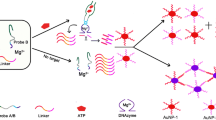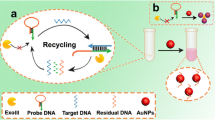Abstract
Various methods have been developed in recent years for the determination of uranyl ion by making use of uranyl-specific DNAzymes. However, many of them suffer from hydrolysis by nucleases present in samples such as body fluids. We report here on an uranyl-specific nuclease-resistant DNA aptamer (UApt) as the recognition element, and how gold nanoparticles (AuNPs) can be used as signal reporters in the respective assay. The presence of uranyl ion leads to a conformational change of UApt, and this results in the dispersion of AuNPs and a decrease in the intensity of resonance light scattering (RLS) at around 573.0 nm. The conformational changes were also studied by polyacrylamide gel electrophoresis, circular dichroism, and UV–vis spectroscopy. The RLS signals are linearly related to the concentration of uranyl ion in the 22 to 550 nM range, with a detection limit of 6.7 nM. This method is more simple and robust than others owing to use of a UApt without a ribonucleotide adenosine. It has been successfully applied to the determination of uranyl ion in real samples. We presume that this method may be extended to the determination of other analytes by making use of the corresponding aptamer for the target.

The presence of UO2 2+ leads to the conformation change of UApt, resulting in the dispersion of AuNPs and decrease of the RLS intensity of the system.




Similar content being viewed by others
References
Darolles C, Broggio D, Feugier A, Frelon S, Dublineau I, De Meo M, Petitot F (2010) Different genotoxic profiles between depleted and enriched uranium. Toxicol Lett 192:337–348
Pereira S, Camilleri V, Floriani M, Cavalié I, Garnier-Laplace J, Adam- Guillermin C (2012) Genotoxicity of uranium contamination in embryonic zebrafish cells. Aquat Toxicol 109:11–16
Nriagu J, Nam DH, Ayanwola TA, Dinh H, Erdenechimeg E, Ochir C, Bolormaa TA (2012) High levels of uranium in groundwater of Ulaanbaatar, Mongolia. Sci Total Environ 414:722–726
Banday AA, Priyamvada S, Farooq N, Yusufi AN, Khan F (2008) Effect of uranyl nitrate on enzymes of carbohydrate metabolism and brush border membrane in different kidney tissues. Food Chem Toxicol 46:2080–2088
Shaki F, Hosseini MJ, Ghazi-Khansari M, Pourahmad J (2012) Toxicity of depleted uranium on isolated rat kidney mitochondria. Biochim Biophys Acta Gen Subj 1820:1940–1950
Boulyga SF, Becker JS, Matusevitch JL, Dietze HJ (2000) Isotope ratio measurements of spent reactor uranium in environmental samples by using inductively coupled plasma mass spectrometry. Int J Mass Spectrom 203:143–154
Misra NL, Dhara S, Óvári M, Záray G, Aggarwal SK, Varga I (2010) Determination of low atomic number elements at trace levels in uranium matrix using vacuum chamber total reflection X-ray fluorescence. Spectrochim Acta B 65:457–460
Lehmann S, Geipel G, Grambole G, Bernhard G (2009) A novel time-resolved laser fluorescence spectroscopy system for research on complexation of uranium(IV). Spectrochim Acta A 73:902–908
Sladkov V, Fourest B (2009) Simultaneous determination of uranium carbide dissolution products by capillary zone electrophoresis. J Chromatogr A 1216:2605–2608
Sladkov V, Zhao Y, Mercier-Bion F (2011) Capillary zone electrophoresis for U(VI) and short chain carboxylic acid sorption studies on silica and rutile. Talanta 83:1595–1600
Lee JH, Wang Z, Liu J, Lu Y (2008) Highly sensitive and selective colorimetric sensors for uranyl (UO22+): Development and comparison of labeled and label-free DNAzyme-gold nanoparticle systems. J Am Chem Soc 130:14217–14226
Liu J, Brown AK, Meng X, Cropek DM, Istok JD, Watson DB, Lu Y (2007) A catalytic beacon sensor for uranium with parts-pertrillion sensitivity and millionfold selectivity. Proc Natl Acad Sci U S A 104:2056–2061
Liu J, Cao Z, Lu Y (2009) Functional nucleic acid sensors. Chem Rev 109:1948–1998
Jiang Z, Zhang Y, Liang A, Chen C, Tian J, Li T (2012) Free-labeled nanogold catalytic detection of trace UO22+ based on the aptamer reaction and gold particle resonance scattering effect. Plasmonics 7:185–190
Xiang Y, Lu Y (2011) Using personal glucose meters and functional DNA sensors to quantify a variety of analytical targets. Nat Chem 3:697–703
Zhou B, Shi LF, Wang YS, Yang HX, Xue JH, Liu L, Wang YS, Yin JC, Wang JC (2013) Resonance light scattering determination of uranyl based on labeled DNAzyme–gold nanoparticle system. Spectrochim Acta A 110:419–424
Fan Y, Long YF, Li YF (2009) A sensitive resonance light scattering spectrometry of trace Hg2+ with sulfur ion modified gold nanoparticles. Anal Chim Acta 653:207–211
Zou QC, Zhang JZ, Chai SG (2011) Resonance light scattering method for the determination of DNA with cationic methacrylate based polymer nanoparticle probes. Spectrochim Acta A 82:437–443
Tang Q, Yuan Y, Xiao X, Hu J, Ma D, Gao Y (2013) DNAzyme based electrochemical sensors for trace uranium. Microchim Acta 180(11–12):1059–1064
Brown AK, Liu J, He Y, Lu Y (2009) Biochemical characterization of a uranyl ion-specific DNAzyme. ChemBioChem 10:486–492
Yin BC, Zuo P, Huo H, Zhong X, Ye BC (2010) DNAzyme self-assembled gold nanoparticles for determination of metal ions using fluorescence anisotropy assay. Anal Biochem 401:47–52
Wang L, Yang CYJ, Medley CD, Benner SA, Tan WH (2005) Locked nucleic acid molecular beacons. J Am Chem Soc 127:15664–15665
Kim J, Kim MY, Kim HS, Hah SS (2011) Binding of uranyl ion by a DNA aptamer attached to a solid support. Bioorg Med Chem Lett 21:4020–4022
Miao XM, Ling LS, Shuai XT (2012) Detection of Pb2+ at attomole levels by using dynamic light scattering and unmodified gold nanoparticles. Anal Biochem 421:582–586
Xu Z, Huang X, Dong C, Ren J (2013) Fluorescence correlation spectroscopy of gold nanoparticles, and its application to an aptamer-based homogeneous thrombin assay. Microchim Acta. doi:10.1007/s00604-013-1132-2
Zhu J, Li T, Zhang L, Dong S, Wang E (2011) G-quadruplex DNAzyme based molecular catalytic beacon for label-free colorimetric logic gates. Biomaterials 32:7318–7324
Gou XC, Liu J, Zhang HL (2010) Monitoring human telomere DNA hybridization and G-quadruplex formation using gold nanorods. Anal Chim Acta 668:208–214
Rajesh J, Gubendran A, Rajagopal G, Athappan P (2012) Synthesis, spectra and DNA interactions of certain mononuclear transition metal(II) complexes of macrocyclic tetraaza diacetyl curcumin ligand. J Mol Struct 1010:169–178
Zheng B, Cheng S, Liu W, Lam MHW, Liang H (2012) A simple colorimetric pH alarm constructed from DNA–gold nanoparticles. Anal Chim Acta 741:106–113
Zhao W, Chiuman W, Lam JCF, McManus SA, Chen W, Cui Y, Pelton R, Brook MA, Li Y (2008) DNA aptamer folding on gold nanoparticles: from colloid chemistry to biosensors. J Am Chem Soc 130:3610–3618
Purohit PJ, Goyal N, Thulasidas SK, Page AG, Sastry MD (2000) Electrothermal vaporization – inductively coupled plasma-atomic emission spectrometry for trace metal determination in uranium and thorium compounds without prior matrix separation. Spectrochim Acta B 55:1257–1270
Jain VK, Pandya RA, Pillai SG, Shrivastav PS (2006) Simultaneous preconcentration of uranium(VI) and thorium(IV) from aqueous solutions using a chelating calix[4]arene anchored chloromethylated polystyrene solid phase. Talanta 70:257–266
Ozdemir S, Kilinc E (2012) Geobacillus thermoleovorans immobilized on Amberlite XAD-4 resin as a biosorbent for solid phase extraction of uranium (VI) prior to its spectrophotometric determination. Microchim Acta 178(3–4):389–397
Acknowledgments
The authors gratefully acknowledge the support of the National Natural Science Foundation of China (No. 21177052), the Science and Technology Program of Hunan Province in China (No. 2010SK3039) and the Construct Program of the Key Discipline (Public Health and Preventive Medicine) in Hunan Province.
Author information
Authors and Affiliations
Corresponding author
Electronic supplementary material
Below is the link to the electronic supplementary material.
ESM 1
(PDF 149 kb)
Rights and permissions
About this article
Cite this article
Zhou, B., Wang, YS., Yang, HX. et al. A sensitive resonance light scattering assay for uranyl ion based on the conformational change of a nuclease-resistant aptamer and gold nanoparticles acting as signal reporters. Microchim Acta 181, 1353–1360 (2014). https://doi.org/10.1007/s00604-014-1267-9
Received:
Accepted:
Published:
Issue Date:
DOI: https://doi.org/10.1007/s00604-014-1267-9




